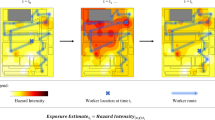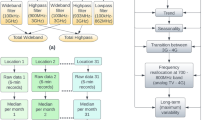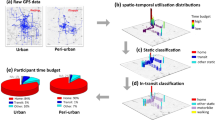Abstract
The MultiWave® System III (MW III), a recently developed personal monitor for extremely low frequency (ELF) magnetic fields, was compared with the standard EMDEX Lite (Electric and Magnetic Field Digital Exposure System), the type of monitor widely used in epidemiology and other exposure assessments. The MW III captures three-axis magnetic field waveforms for the calculation of many exposure metrics, while the EMDEX monitors measure only the root-mean-squared (RMS) vector magnitude (or resultant). Thirty-eight partial period personal samples were monitored in six different job classifications. The sampling time for each personal sample ranged from 90 to 133 min, with a mean sample time of 110 min. The EMDEX Lite and MW III were evaluated by comparing the maximum and partial period time-weighted average (TWA) of the ELF magnitude. TWA exposures measured for the 38 partial period samples by the EMDEX Lite ranged from 1.2 to 65.3 mG, with a mean of 18.1 mG, while corresponding values for the MW III ranged from 1.1 to 65.8 mG, with a mean of 17.7 mG. The maximum magnetic field exposures measured for the 38 partial period personal samples by the EMDEX Lite ranged from 27.0 to 420.2 mG, with a mean of 216.3 mG, while corresponding values for the MW III ranged from 40.2 to 1311.8 mG, with a mean of 368.4 mG. The maximum and TWA ELF magnetic field exposures measured by the EMDEX Lite and MW III were compared using a two-tailed, paired t-test. Analyses indicate that there was no significant difference in the TWA magnetic field magnitude measured by the EMDEX Lite and MW III. On the other hand, the EMDEX Lite reported significantly lower (P=0.002) maximum magnetic field measurements compared to the MW III. From a detailed analysis of the time traces, the EMDEX Lite appears to measure the ELF magnitude inaccurately when the field changes rapidly over a 4-s sampling interval. The results of this comparison suggest that the standard EMDEX Lite and MW III provide similar measure of the TWA magnetic field in a variety of occupational settings and ELF magnetic field magnitudes. However, the EMDEX Lite underestimates maximum exposures when compared to the MW III.
This is a preview of subscription content, access via your institution
Access options
Subscribe to this journal
Receive 6 print issues and online access
$259.00 per year
only $43.17 per issue
Buy this article
- Purchase on Springer Link
- Instant access to full article PDF
Prices may be subject to local taxes which are calculated during checkout




Similar content being viewed by others
References
Bowman JD Methner MM Hazard surveillance for industrial magnetic fields: II. Field characteristics from waveform measurements, Ann Occup Hyg (2000) 44: 615–633
Bowman JD Kelsh MA Kaune WT (editors) Manual for Measuring Occupational Electric and Magnetic Field Exposures. DHHS (NIOSH) Publication 98-154 1998 IV-6 to IV-7
Bowman JD Gailey PC Gillette L Lotz WG Overton D Proceedings of a Joint NIOSH/DOE Workshop “EMF Exposure Assessment and Epidemiology: Hypotheses, Metrics, and Measurements”, Cincinnati, OH, September 26–28, 1994 NIOSH Internet page on EMF http://www.cdc.gov/niosh/emfpg.html 2000
Bracken TD Exposure assessment for power frequency electric and magnetic fields, Am Ind Hyg Assoc J (1993) 54: 165–177
Breysse PN Lees PSJ McDiarmid MA Curbow B ELF magnetic field exposures in an office environment, Am J Ind Med (1994) 25: 177–185
Breysse PN Matanoski GM Elliot EA Francis M Kaune W Thomas K 60 hertz magnetic field exposure assessment for an investigation of leukemia in telephone lineworkers, Am J Ind Med (1994) 26: 681–691
Breysse PN Hollander JN Rooney B Comparison of extremely low frequency magnetic field exposures for electrical and non-electrical workers at a department of energy facility, Occup Hyg (1997) 4: 1–13
Delpizzo V Misclassification of ELF occupational exposure resulting from spatial variation of the magnetic field, Bioelectromagnetics (1993) 14: 117–130
Electric Research and Management Multiwave System II User's Manual, version 4.60. ERM, State College, PA 1997
NIEHS Assessment of Health Effects from Exposure to Power-Line Frequency Electric and Magnetic Fields. National Institute of Environmental Health Working Group, NIEHS (1998) 9–184
Savitz DA Overview of epidemiologic research on electric and magnetic fields and cancer, Am Ind Hyg Assoc J (1993) 54: 197–204
Author information
Authors and Affiliations
Corresponding author
Rights and permissions
About this article
Cite this article
MCDEVITT, J., BREYSSE, P., BOWMAN, J. et al. Comparison of extremely low frequency (ELF) magnetic field personal exposure monitors. J Expo Sci Environ Epidemiol 12, 1–8 (2002). https://doi.org/10.1038/sj.jea.7500194
Received:
Published:
Issue Date:
DOI: https://doi.org/10.1038/sj.jea.7500194
Keywords
This article is cited by
-
Prenatal exposure to extremely low frequency magnetic field and its impact on fetal growth
Environmental Health (2019)
-
Fetal Exposure to Secondhand Tobacco Smoke Assessed by Maternal Self-reports and Cord Blood Cotinine: Prospective Cohort Study in Krakow
Maternal and Child Health Journal (2009)
-
Exposure opportunity models for Agent Orange, dioxin, and other military herbicides used in Vietnam, 1961–1971
Journal of Exposure Science & Environmental Epidemiology (2004)
-
Use of short-term measurements for assessing temporal variability of residential ELF magnetic field exposure
Journal of Exposure Science & Environmental Epidemiology (2003)



